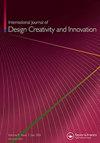在空间增强现实的支持下,对联合创意设计会议期间的评估和想法生成活动的社会认知分析
IF 2.5
Q4 ENGINEERING, MANUFACTURING
International Journal of Design Creativity and Innovation
Pub Date : 2020-12-14
DOI:10.1080/21650349.2020.1854122
引用次数: 6
摘要
摘要如今,设计行业对与最终用户的合作越来越感兴趣。本研究调查了空间增强现实(SAR)技术影响参与共同创意设计会议的群体的社会认知过程的机制。更准确地说,当在真正的共同创意设计会议中使用时,与标准环境中的会议相比,SAR系统是否有助于集体创意过程?已经进行了协议分析,以调查三个不同的设计会议,涉及有经验的设计师和最终用户执行产品设计任务:由传统设计表示支持的设计会议(通常的设计实践)、由非空间增强现实(AR)支持的设计会议和由SAR技术支持的会议。虽然研究结果并没有清楚地表明SAR或AR技术可以提高最终用户的承诺,但它们说明了这些技术在共同创意设计会议期间浏览更多想法的能力。此外,与传统会议相比,它往往会减少花在想法上的时间。我们还注意到,这项技术的引入并没有改变会话在认知活动方面的概况。这往往表明技术本身不会损害设计活动。本文章由计算机程序翻译,如有差异,请以英文原文为准。
A socio-cognitive analysis of evaluation and idea generation activities during co-creative design sessions supported by spatial augmented reality
ABSTRACT Co-creation with end-users is gaining an increasing interest in the design industry today. This study investigates the mechanisms by which spatial augmented reality (SAR) technology can affect socio-cognitive processes in groups involved in co-creative design sessions. More precisely, when used in real co-creative design sessions, does a SAR system facilitate the collective creative process, compared to sessions occurring in standard settings? A protocol analysis has been conducted to investigate three different design sessions involving experienced designers and end-users on a product design task: a design session supported by conventional design representations (usual design practices), a design session supported by non-spatial augmented reality (AR), and a session supported by SAR technology. While results do not clearly show that SAR or AR technologies increase end-user’s commitmen t, they illustrate the ability for these technologies to allow browsing through more ideas during a co-creative design session. Furthermore, it tends to reduce time spent on ideas, compared to a traditional session. We also noted that the introduction of this technology does not modify the profiles of the sessions in terms of cognitive activities. This tends to demonstrate that the technology itself does not impair the design activity.
求助全文
通过发布文献求助,成功后即可免费获取论文全文。
去求助
来源期刊

International Journal of Design Creativity and Innovation
ENGINEERING, MANUFACTURING-
CiteScore
3.80
自引率
27.80%
发文量
15
期刊介绍:
The International Journal of Design Creativity and Innovation is an international publication that provides a forum for discussing the nature and potential of creativity and innovation in design from both theoretical and practical perspectives. Design creativity and innovation is truly an interdisciplinary academic research field that will interest and stimulate researchers of engineering design, industrial design, architecture, art, and similar areas. The journal aims to not only promote existing research disciplines but also pioneer a new one that lies in the intermediate area between the domains of systems engineering, information technology, computer science, social science, artificial intelligence, cognitive science, psychology, philosophy, linguistics, and related fields. The journal covers, but is not restricted to, the following topics: ·Theories on Design Creativity and Innovation ·Cognition of Design Creativity ·Innovative Process ·Inventive Process ·Analogical Reasoning for Design Creativity and Innovation ·Design Synthesis ·Method and Tools for Design Creativity and Innovation ·Representation of Design Creativity and Innovation ·Education for Design Creativity and Innovation ·Concept Generation and Inspiration.
 求助内容:
求助内容: 应助结果提醒方式:
应助结果提醒方式:


